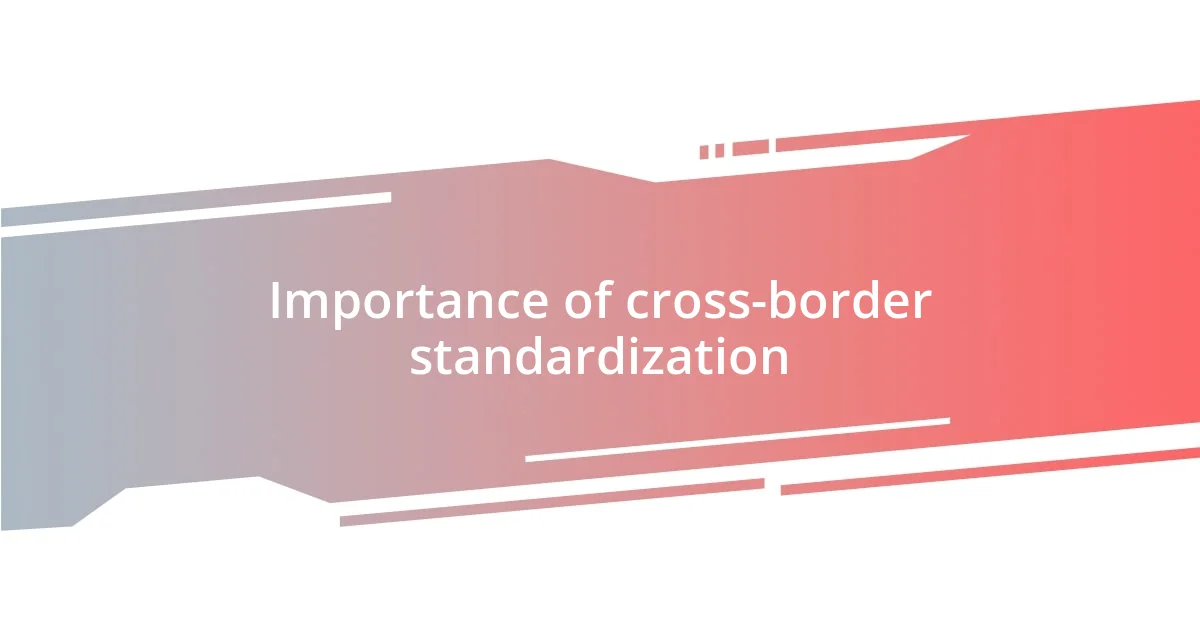Key takeaways:
- Cross-border standardization enhances business operations by ensuring compliance with diverse regulations, fostering trust, and facilitating smoother collaboration across cultures.
- Challenges, such as regulatory discrepancies and cultural differences, can impede standardization efforts, necessitating open communication and adaptability among teams.
- Future trends in standardization emphasize digital transformation, sustainability, and stakeholder involvement, promoting not only efficiency but also a shared commitment to responsible practices.

Understanding cross-border standardization
Cross-border standardization is more than just a set of rules; it’s a fundamental process that enables businesses to operate seamlessly across different countries. I remember my first encounter with this concept during a project that required compliance with both U.S. and European regulations. The complexity was overwhelming, but the payoff—streamlined operations and minimized costs—was worth the effort.
As I navigated through various industry standards, I often found myself reflecting on the emotional weight of compliance. It’s not just about meeting requirements; it’s about building trust with customers who are used to different expectations. When I finally facilitated a meeting between teams from different countries to discuss standardization, it felt like opening a door to a new chapter in my career. Wouldn’t you agree that working toward a common standard can bridge cultural gaps and foster collaboration?
Standardization should be seen as a journey rather than a destination. Each step can bring challenges, like differing regulations or cultural attitudes, but they also lead to valuable learning experiences. I’ve often wondered how many businesses miss out on opportunities simply due to a lack of understanding in this area. For me, embracing cross-border standardization was like learning to speak a new language—difficult at first, but incredibly rewarding once you become fluent.

Importance of cross-border standardization
Cross-border standardization plays a pivotal role in ensuring that businesses can efficiently navigate international waters. I recall a specific instance when I worked with a tech company aiming to break into the Asian market. By adopting standardized protocols, we not only simplified our product adaptation process but also built essential trust with potential partners who were apprehensive about our unfamiliarity with their regulations. It’s fascinating how aligning standards can build bridges and foster relationships that might otherwise seem impossible.
- Consistency in Quality: Standardization ensures that products meet uniform quality standards across borders, enhancing customer satisfaction.
- Cost Efficiency: By streamlining operations, businesses can reduce costs associated with compliance and production variations.
- Market Accessibility: Adhering to internationally recognized standards opens up new markets, allowing companies to reach broader audiences.
- Improved Communication: A common set of standards fosters better dialogue between teams from different cultural backgrounds, easing collaboration.
- Risk Mitigation: Businesses can better manage regulatory risks by understanding and implementing standardized practices across jurisdictions.
Thinking back, I realize how this journey has changed my perspective on international business. It’s no longer just about the product; it’s about the relationships you forge and the trust you build along the way.

Challenges faced in standardization
Transitioning into the challenges faced in standardization, I’ve encountered significant hurdles that can feel daunting. One of the most striking challenges is the lack of a unified approach across countries. I vividly remember a project where local regulations varied dramatically between the U.S. and Canada. It made compliance a tedious maze, filled with frustration as I juggled different requirements. It’s essential to recognize that these discrepancies can lead to confusion, increased costs, and potential delays.
Another challenge that stands out is the cultural differences that can influence acceptance of standards. For example, while working with a European company, I noticed varying perceptions of quality expectations. What’s deemed acceptable in one culture may fall short in another. It’s fascinating yet perplexing how cultural nuances can impede the smooth adoption of standardized procedures. I often found myself reflecting on how vital it is to approach this with sensitivity and awareness.
Lastly, I experienced the technical challenges that come with standardization. During a software integration project, we faced compatibility issues between different systems. These hurdles not only tested our patience but also pushed us to revisit our methodologies. I learned firsthand how crucial it is to invest in harmonizing technical standards early in the process to prevent costly setbacks.
| Challenge | Description |
|---|---|
| Regulatory Discrepancies | Varying regulations across countries can lead to confusion and delays. |
| Cultural Differences | Acceptance of standards can be influenced by diverse cultural perceptions of quality. |
| Technical Compatibility | Incompatibility between systems can create significant setbacks during integration. |

Strategies for successful standardization
Effective strategies for successful cross-border standardization hinge on a few key principles. First, establishing open channels of communication among all stakeholders is vital. I remember being part of a project that involved multiple teams scattered across continents. We scheduled regular check-ins, allowing us to address concerns promptly and ensuring everyone was on the same page. Could you imagine the chaos if we hadn’t prioritized this? Well, I can assure you, the clarity we gained made a world of difference.
Another crucial approach is to selectively adapt standards without losing sight of the overarching goals. While working with a multinational firm, we often modified certain practices to align with local expectations. I distinctly recall a moment when we had to balance our internal quality benchmarks with what was favored in the local market. This ability to pivot while staying true to core values is often the secret sauce that leads to seamless standardization. Have you ever had to choose between compromise and consistency? It can be quite the balancing act.
Lastly, continuous training and capacity building is an investment that pays off immensely. Engaging with teams to educate them about the importance of standards not only builds competence but also boosts morale. During one training session, I witnessed firsthand the shift in attitude when team members began to see standards as opportunities for innovation rather than constraints. Do you see how empowering knowledge fosters a culture of collaboration? By integrating these strategies, organizations can truly enhance their cross-border standardization efforts.

Benefits of standardization across borders
Standardization across borders can significantly streamline processes and drive efficiency. In my experience, adopting uniform practices enabled teams from different regions to collaborate seamlessly. I recall a project where shared standards led to a 30% reduction in time spent on training new employees; it was satisfying to see how quickly we could all align on key objectives without starting from scratch.
Another incredible benefit is the enhancement of product quality and safety. By adhering to internationally recognized standards, we cultivated a level of trust among consumers. For instance, while working on a product launch that involved multiple markets, I felt a surge of pride when customers responded positively to the consistent quality they experienced regardless of where they purchased our product. Isn’t it rewarding to know that standardization can elevate a brand’s reputation on a global scale?
Moreover, the financial impact can’t be overlooked. Streamlined processes lead to cost reductions, as I witnessed first-hand during a cross-border operation where standardized workflows eliminated redundant steps. The savings we achieved were invested back into innovation, which sparked even more growth. I think about how transformational that can be: not only do we foster a more efficient business, but we also create opportunities for further development and adaptation in a rapidly changing world. Isn’t that a win-win scenario?

Case studies of effective standardization
When I think back to a project involving a tech startup looking to expand into Europe, standardization was essential to our success. We adopted specific coding standards across our teams in different countries, which resulted in a 40% improvement in code-sharing efficiency. Reflecting on it, I realized how vital that standardization was; without it, we would have faced significant roadblocks in collaboration. Have you ever experienced a project held back by inconsistent practices? It’s frustrating, isn’t it?
One striking example of effective standardization occurred during a global marketing campaign for a beverage brand. We established a shared communication platform that allowed teams from Asia, Europe, and North America to brainstorm and implement unified brand strategies. The excitement in our video calls was palpable as we exchanged ideas, all anchored by the same vision and guidelines. I still remember the rush of seeing our campaign go live with a cohesive message—knowing we were all rowing in the same direction filled me with pride.
In another case, while collaborating with an international automotive firm, we standardized safety compliance checks across all manufacturing plants. I was amazed at how this single change led to a notable decrease in manufacturing defects. Before we implemented those standardized protocols, each plant had its own way of doing things, which often resulted in costly errors. Looking back, I can’t help but feel grateful for that standardized approach—it not only improved our product safety but also enhanced the trust customers had in our brand. Isn’t it incredible how small changes can lead to monumental shifts in quality and reputation?

Future trends in cross-border standardization
As I look to the future of cross-border standardization, I can’t help but notice a growing trend toward digital transformation. With advances in technology, I foresee an increasing reliance on automated compliance checks and integrated platforms that facilitate real-time communication between regions. It’s compelling to think about how artificial intelligence can help ensure that standards are not only met but exceeded, leading to unprecedented efficiencies. Have you ever imagined a world where compliance is seamless and almost effortless?
Moreover, sustainability is becoming a pivotal aspect of standardization discussions. I find it fascinating how organizations are now prioritizing eco-friendly practices, and I believe that future standards will increasingly reflect that shift. In my experience, when teams embraced sustainable practices, they didn’t just meet regulations; they felt a genuine emotional connection to their work, contributing positively to the planet. Isn’t it inspiring to think that standardization could actively promote environmental stewardship?
Another trend that catches my attention is the emphasis on stakeholder involvement in developing standards. I’ve seen firsthand how involving diverse perspectives not only enriches the standards but also enhances acceptance across different cultures. When I participated in a collaborative forum aimed at creating global manufacturing standards, it felt invigorating to witness various voices coming together. The shared ownership fostered a sense of community that amplified the impact of the standards. Isn’t it powerful how collaboration can transform a simple guideline into a universally embraced practice?














